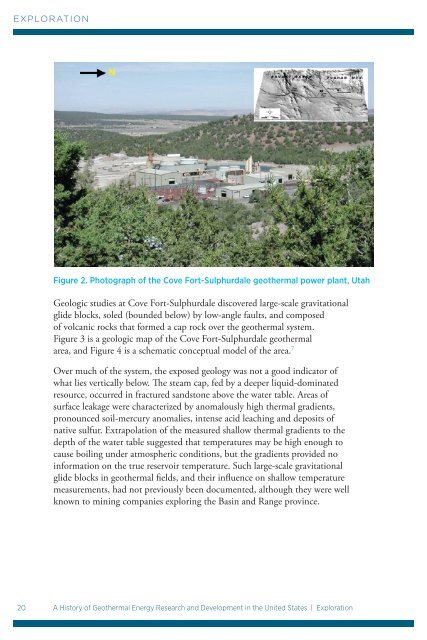A History of Geothermal Energy Research and Development in the ...
A History of Geothermal Energy Research and Development in the ...
A History of Geothermal Energy Research and Development in the ...
Create successful ePaper yourself
Turn your PDF publications into a flip-book with our unique Google optimized e-Paper software.
EXPLORATION<br />
Figure 2. Photograph <strong>of</strong> <strong>the</strong> Cove Fort-Sulphurdale geo<strong>the</strong>rmal power plant, Utah<br />
Geologic studies at Cove Fort-Sulphurdale discovered large-scale gravitational<br />
glide blocks, soled (bounded below) by low-angle faults, <strong>and</strong> composed<br />
<strong>of</strong> volcanic rocks that formed a cap rock over <strong>the</strong> geo<strong>the</strong>rmal system.<br />
Figure 3 is a geologic map <strong>of</strong> <strong>the</strong> Cove Fort-Sulphurdale geo<strong>the</strong>rmal<br />
area, <strong>and</strong> Figure 4 is a schematic conceptual model <strong>of</strong> <strong>the</strong> area. 7<br />
Over much <strong>of</strong> <strong>the</strong> system, <strong>the</strong> exposed geology was not a good <strong>in</strong>dicator <strong>of</strong><br />
what lies vertically below. The steam cap, fed by a deeper liquid-dom<strong>in</strong>ated<br />
resource, occurred <strong>in</strong> fractured s<strong>and</strong>stone above <strong>the</strong> water table. Areas <strong>of</strong><br />
surface leakage were characterized by anomalously high <strong>the</strong>rmal gradients,<br />
pronounced soil-mercury anomalies, <strong>in</strong>tense acid leach<strong>in</strong>g <strong>and</strong> deposits <strong>of</strong><br />
native sulfur. Extrapolation <strong>of</strong> <strong>the</strong> measured shallow <strong>the</strong>rmal gradients to <strong>the</strong><br />
depth <strong>of</strong> <strong>the</strong> water table suggested that temperatures may be high enough to<br />
cause boil<strong>in</strong>g under atmospheric conditions, but <strong>the</strong> gradients provided no<br />
<strong>in</strong>formation on <strong>the</strong> true reservoir temperature. Such large-scale gravitational<br />
glide blocks <strong>in</strong> geo<strong>the</strong>rmal fields, <strong>and</strong> <strong>the</strong>ir <strong>in</strong>fluence on shallow temperature<br />
measurements, had not previously been documented, although <strong>the</strong>y were well<br />
known to m<strong>in</strong><strong>in</strong>g companies explor<strong>in</strong>g <strong>the</strong> Bas<strong>in</strong> <strong>and</strong> Range prov<strong>in</strong>ce.<br />
20 A <strong>History</strong> <strong>of</strong> <strong>Geo<strong>the</strong>rmal</strong> <strong>Energy</strong> <strong>Research</strong> <strong>and</strong> <strong>Development</strong> <strong>in</strong> <strong>the</strong> United States | Exploration

















